Thermomechanical Autovaporization (MFA) as a Deodorization Process of Palm Oil
Abstract
:1. Introduction
2. Materials and Methods
2.1. Resources
2.2. Chemical Products
2.3. Experimental Methodology
2.4. Deodorization by Multi-Flash Autovaporization MFA Process
2.5. Assessments and Characteristics
2.5.1. Identification of Volatile Compounds of the Palm Oil
2.5.2. Chromatographic Measurements
2.5.3. Using Conditions of the GC-MS
2.5.4. Design of Experiments (DoE)
3. Results and Discussion
3.1. Profile of Volatile Molecules as a Function of MFA Processing Parameters
3.2. Multi-Flash MFA Autovaporization as a Deodorization Process
3.3. Statistical Analysis
3.4. Optimization of AMF Pretreatment
Impact of MFA Treatments on Palm Oil Quality
4. Conclusions
Author Contributions
Funding
Institutional Review Board Statement
Informed Consent Statement
Data Availability Statement
Acknowledgments
Conflicts of Interest
References
- Erickson, D.R. Overview of Modern Soybean Processing and Links Between Processes. In Practical Handbook of Soybean Processing and Utilization; Erickson, D.R., Ed.; AOCS Press: Urbana, IL, USA, 1995; pp. 56–64. [Google Scholar]
- Sampaio, K.A.; Ayala, J.V.; Silva, S.M.; Ceriani, R.; Verhé, R.; Meirelles, A.J.A. Thermal Degradation Kinetics of Carotenoids in Palm Oil. J. Am. Oil Chem. Soc. 2013, 90, 191–198. [Google Scholar] [CrossRef]
- May, C.Y.; Nesaretnam, K. Research advancements in palm oil nutrition. Eur. J. Lipid Sci. Technol. 2014, 116, 1301–1315. [Google Scholar] [CrossRef] [Green Version]
- Mayamol, P.N.; Balachandran, C.; Samuel, T.; Sundaresan, A.; Arumughan, C. Process Technology for the Production of Micronutrient Rich Red Palm Olein. J. Am. Oil Chem. Soc. 2007, 84, 587–596. [Google Scholar] [CrossRef]
- Aluyor, E.O.; Aluyor, P.; Ozigagu, C.E. Effect of refining on the quality and composition of groundnut oil 5. Afr. J. Food Sci. 2009, 3, 201–205. [Google Scholar]
- Filip, S.; Fink, R.; Hribar, J.; Vidrih, R. ChemInform Abstract: Trans Fatty Acids in Food and Their Influence on Human Health. ChemInform 2011, 42, 135. [Google Scholar] [CrossRef]
- Razak, R.A.A.; Kuntom, A.; Siew, W.L.; Ibrahim, N.A.; Ramli, M.R.; Hussein, R.; Nesaretnam, K. Detection and monitoring of 3-monochloropropane-1,2-diol (3-MCPD) esters in cooking oils. Food Control 2012, 25, 355–360. [Google Scholar] [CrossRef]
- Restiawaty, E.; Maulana, A.; Culsum, N.T.U.; Aslan, C.; Suendo, V.; Nishiyama, N.; Budhi, Y.W. The removal of 3-monochloropropane-1,2-diol ester and glycidyl ester from refined-bleached and deodorized palm oil using activated carbon. RSC Adv. 2021, 11, 16500–16509. [Google Scholar] [CrossRef] [PubMed]
- Moreno, M.M.; Olivares, D.M.; López, F.A.; Adelantado, J.G.; Reig, F.B. Determination of unsaturation grade and trans isomers generated during thermal oxidation of edible oils and fats by FTIR. J. Mol. Struct. 1999, 482–483, 551–556. [Google Scholar] [CrossRef]
- Mozaffarian, D.; Katan, M.B.; Ascherio, A.; Stampfer, M.J.; Willett, W.C. Trans Fatty Acids and Cardiovascular Disease. New Engl. J. Med. 2006, 354, 1601–1613. [Google Scholar] [CrossRef] [Green Version]
- Greyt, W.D. Developments in edible oil refining for the production of high quality, contaminant—Free food oils. In Proceedings of the 2010 National Seminar Palm Oil Milling, Refining, Environment and Quality (POMREQ), Kota Kinabalu, Malaysia, 27–28 September 2010. [Google Scholar]
- Xiao, L.; Li, C.; Chai, D.; Chen, Y.; Wang, Z.; Xu, X.; Wang, Y.; Geng, Y.; Dong, L. Volatile compound profiling from soybean oil in the heating process. Food Sci. Nutr. 2020, 8, 1139–1149. [Google Scholar] [CrossRef]
- Verleyen, T.; Verhe, R.; Garcia, L.; Dewettinck, K.; Huyghebaert, A.; De Greyt, W. Gas chromatographic characterization of vegetable oil deodorization distillate. J. Chromatogr. A 2001, 921, 277–285. [Google Scholar] [CrossRef]
- Jamoussi, B.; Jablaoui, C.; Hajri, A.K.; Chakroun, R.; Al-Mur, B.; Allaf, K. Deodorization process of vegetal soybean oil using Thermomechanical Multi-Flash Autovaporization (MFA). LWT 2022, 167, 113823. [Google Scholar] [CrossRef]
- Jablaoui, C.; Zeaiter, A.; Bouallegue, K.; Jemoussi, B.; Besombes, C.; Allaf, T.; Allaf, K. Instant controlled pressure drop as new intensification ways for vegetal oil extraction. In Green Food Processing Techniques; Chemat, F., Vorobiev, E., Eds.; Academic Press: Cambridge, MA, USA, 2019; pp. 221–244. [Google Scholar]
- Jablaoui, C.; Besombes, C.; Jamoussi, B.; Rhazi, L.; Allaf, K. Comparison of expander and Instant Controlled Pressure-Drop DIC technologies as thermomechanical pretreatments in enhancing solvent extraction of vegetal soybean oil. Arab. J. Chem. 2020, 13, 7235–7246. [Google Scholar] [CrossRef]
- Song, J.; Gardner, B.D.; Holland, A.J.F.; Beaudry, R.M. Rapid Analysis of Volatile Flavor Compounds in Apple Fruit Using SPME and GC/Time-of-Flight Mass Spectrometry. J. Agric. Food Chem. 1997, 45, 1801–1807. [Google Scholar] [CrossRef]
- Arthur, C.L.; Pawliszyn, J. Solid phase microextraction with thermal desorption using fused silica optical fibers. Anal. Chem. 1990, 62, 2145–2148. [Google Scholar] [CrossRef]
- Snyder, J.M.; Frankel, E.N.; Selke, E. Capillary gas chromatographic analyses of headspace volatiles from vegetable oils. J. Am. Oil Chem. Soc. 1985, 62, 1675. [Google Scholar] [CrossRef]
- Carasek, E.; Pawliszyn, J. Screening of Tropical Fruit Volatile Compounds Using Solid-Phase Microextraction (SPME) Fibers and Internally Cooled SPME Fiber. J. Agric. Food Chem. 2006, 54, 8688–8696. [Google Scholar] [CrossRef]
- Leão, K.M.; Sampaio, K.L.; Pagani, A.A.; Da Silva, M.A.A. Odor potency, aroma profile and volatiles composition of cold pressed oil from industrial passion fruit residues. Ind. Crop. Prod. 2014, 58, 280–286. [Google Scholar] [CrossRef]
- Allaf, T.; Fine, F.; Tomao, V.; Nguyen, C.; Ginies, C.; Chemat, F. Impact of instant controlled pressure drop pre-treatment on solvent extraction of edible oil from rapeseed seeds. OCL 2014, 21, A301. [Google Scholar] [CrossRef] [Green Version]
- Mnayer, D. Eco-Extraction des Huiles Essentielles et des Arômes Alimentaires en Vue d’une Application comme Agents Antioxydants et Antimicrobiens. Ph.D. Thesis, Université d’Avignon, Avignon, France, 2014. [Google Scholar]
- Giuffrè, A.M.; Capocasale, M.; Macrì, R.; Caracciolo, M.; Zappia, C.; Poiana, M. Volatile profiles of extra virgin olive oil, olive pomace oil, soybean oil and palm oil in different heating conditions. LWT 2020, 117, 108631. [Google Scholar] [CrossRef]
- Verevkin, S.P.; Krasnykh, E.L.; Vasiltsova, T.V.; Koutek, B.; Doubsky, J.; Heintz, A. Vapor pressures and enthalpies of vaporization of a series of the linear aliphatic aldehydes. Fluid Phase Equilibria 2003, 206, 331–339. [Google Scholar] [CrossRef]
- Gibon, V.; De Greyt, W.; Kellens, M. Palm oil refining. Eur. J. Lipid Sci. Technol. 2007, 109, 315–335. [Google Scholar] [CrossRef]
- Liu, X.; Zhou, S.; Jiang, Y.; Xu, X. Optimization of Deodorization Design for Four Different Kinds of Vegetable Oil in Industrial Trial to Reduce Thermal Deterioration of Product. J. Am. Oil Chem. Soc. 2021, 98, 475–483. [Google Scholar] [CrossRef]
- Mannaï, A.; Jablaoui, C.; Hamrouni, L.; Allaf, K.; Jamoussi, B. Correction: DIC as a pretreatment prior to ultrasonic extraction for the improvement of rebaudioside A yield and preservation of vitamin B1 and B6. J. Food Meas. Charact. 2022, 16, 4372. [Google Scholar] [CrossRef]
- Jablaoui, C. « La texturation par detente instantannée [sic] controlée DIC dans le developpements [sic] de nouvelles opérations d’extraction d’huiles des graines oleagineuses ». Ph.D. Thesis, Université de La Rochelle, Université de Carthage (Tunisie), Carthage, Tunisia, 2018. Available online: https://tel.archives-ouvertes.fr/tel-02009847 (accessed on 4 December 2022).
- Lee, A.P.; King, W.G. Edible oil deodorizing equipment and methods. J. Am. Oil Chem. Soc. 1937, 14, 263–269. [Google Scholar] [CrossRef]
- Yang, C.; Wang, C.; Wang, M.; Qin, X.; Hao, G.; Kang, M.; Hu, X.; Cheng, Y.; Shen, J. A novel deodorization method of edible oil by using ethanol steam at low temperature. J. Food Sci. 2021, 86, 394–403. [Google Scholar] [CrossRef]
- Mursalin, M. Engineering Process Of Deodorization To Improve Product Quality Of Red Palm Oil With Rich Of Carotene. Indones. Food Sci. Technol. J. 2018, 1, 20–26. [Google Scholar] [CrossRef]
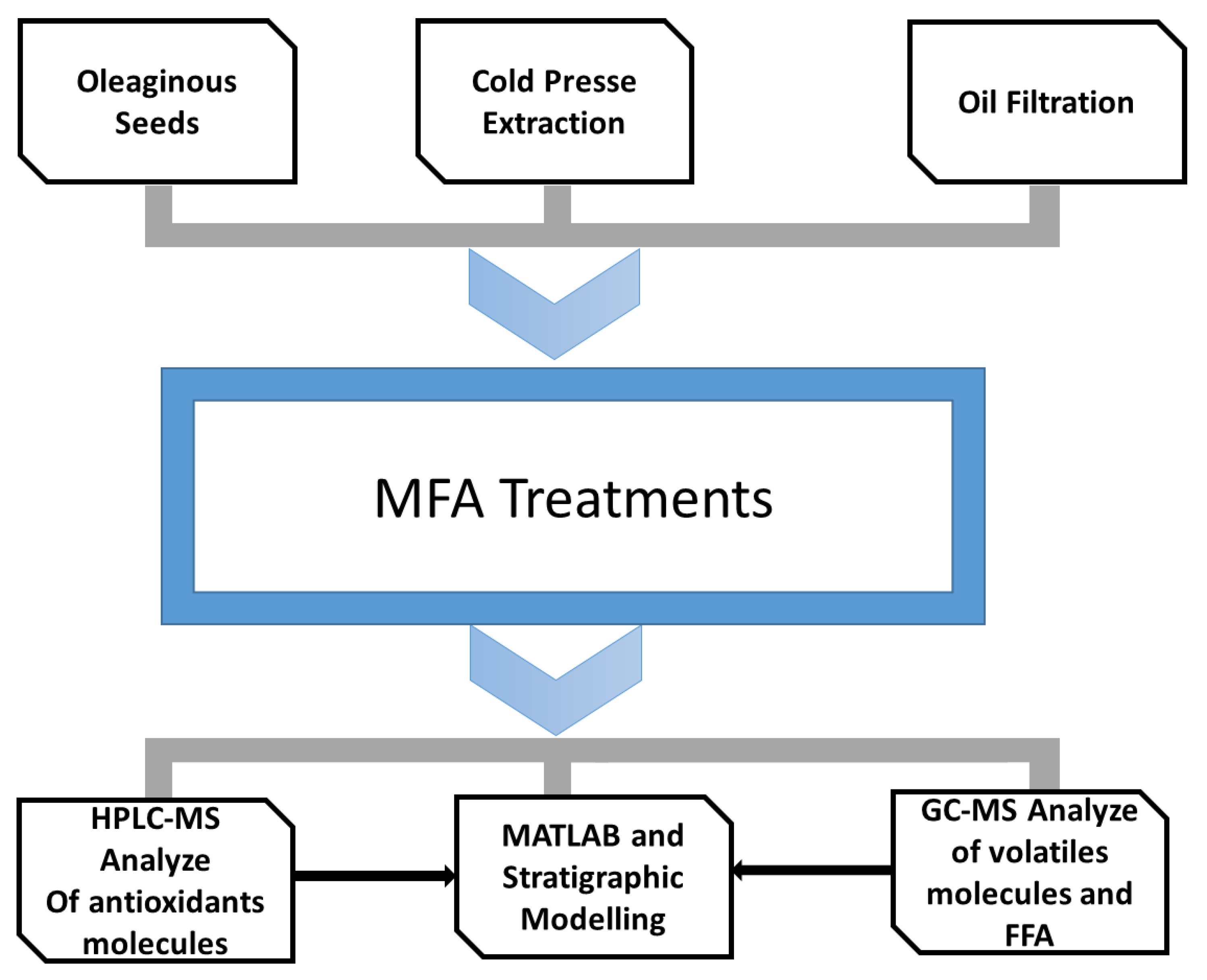
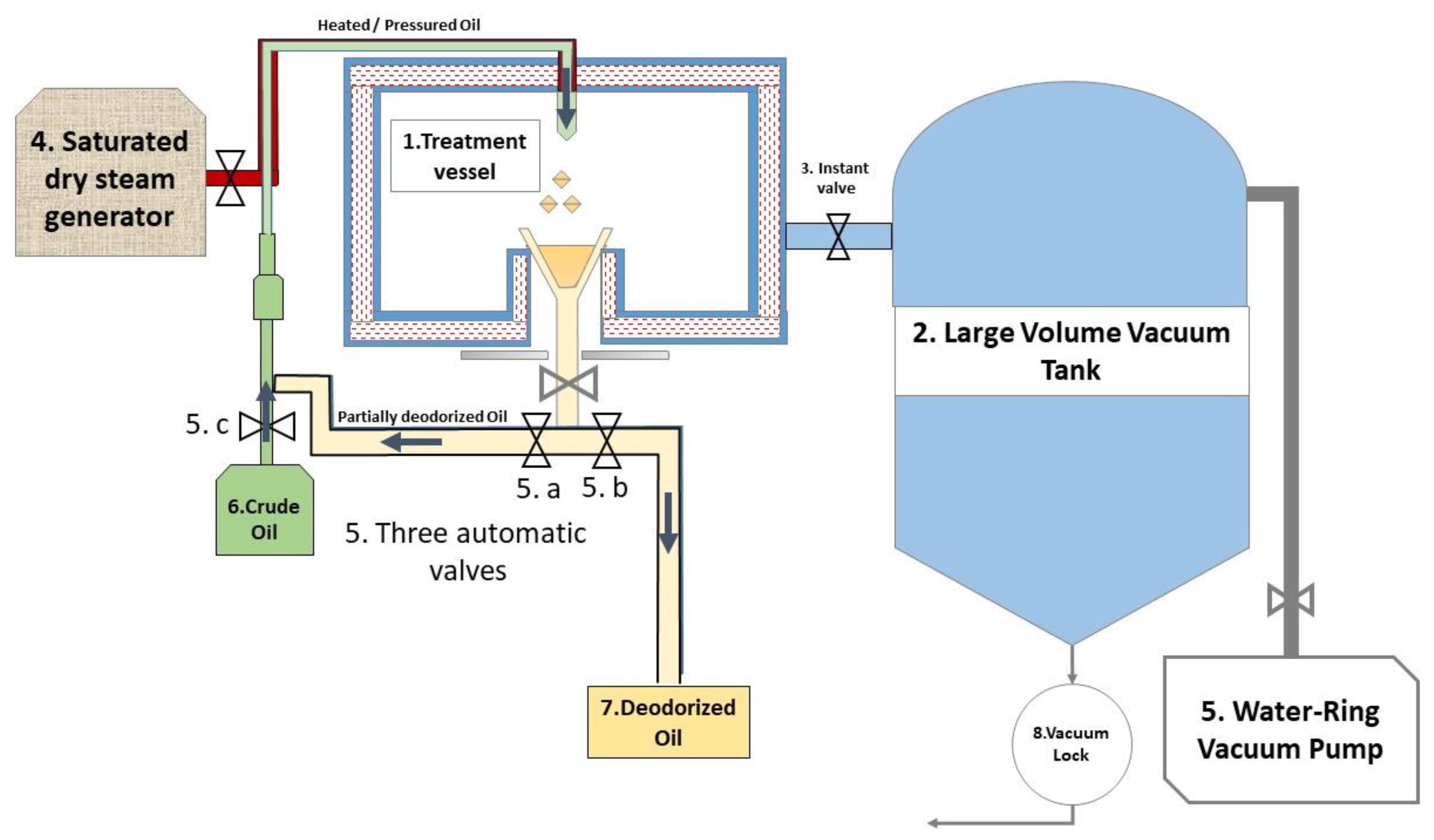
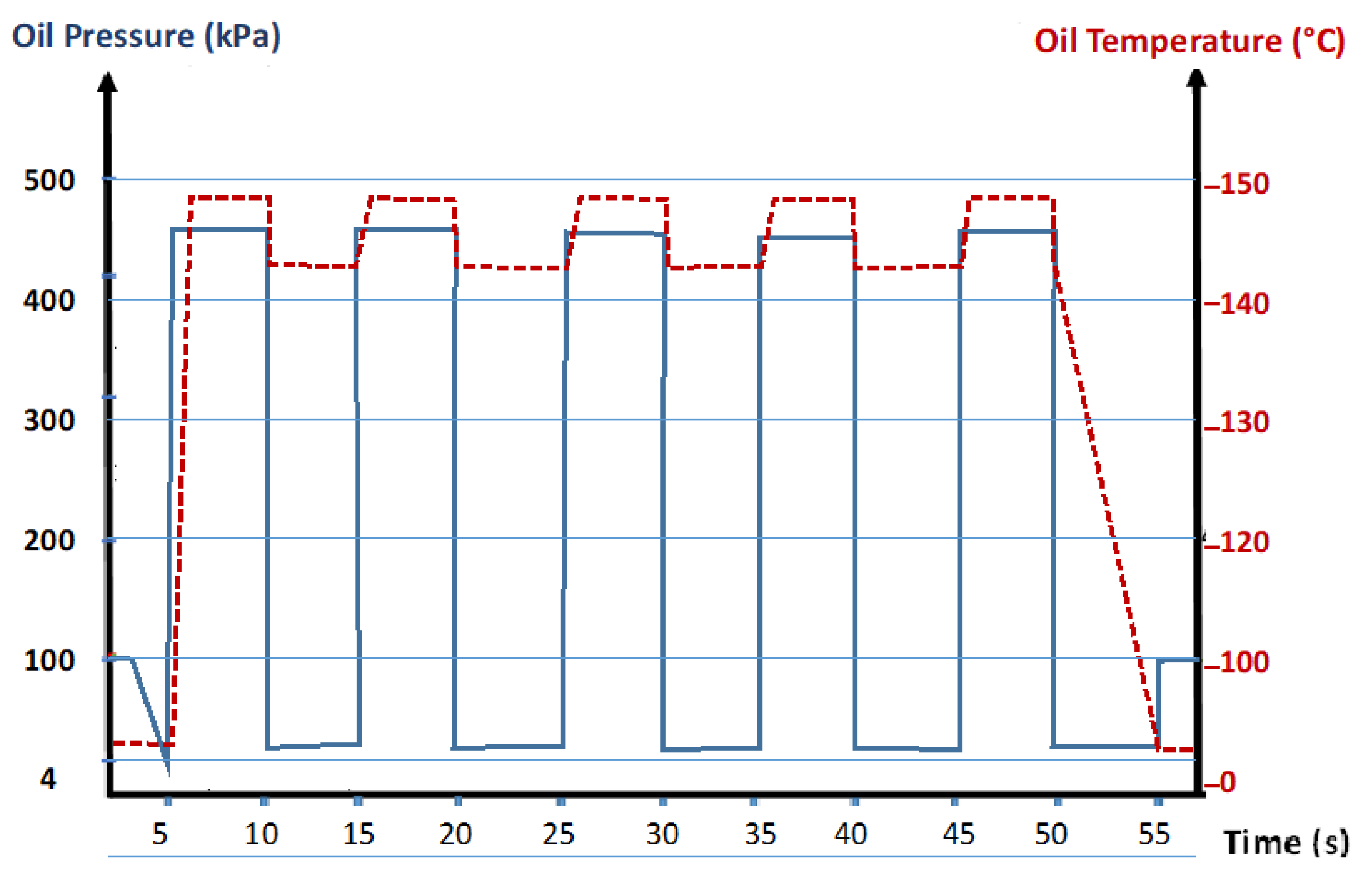
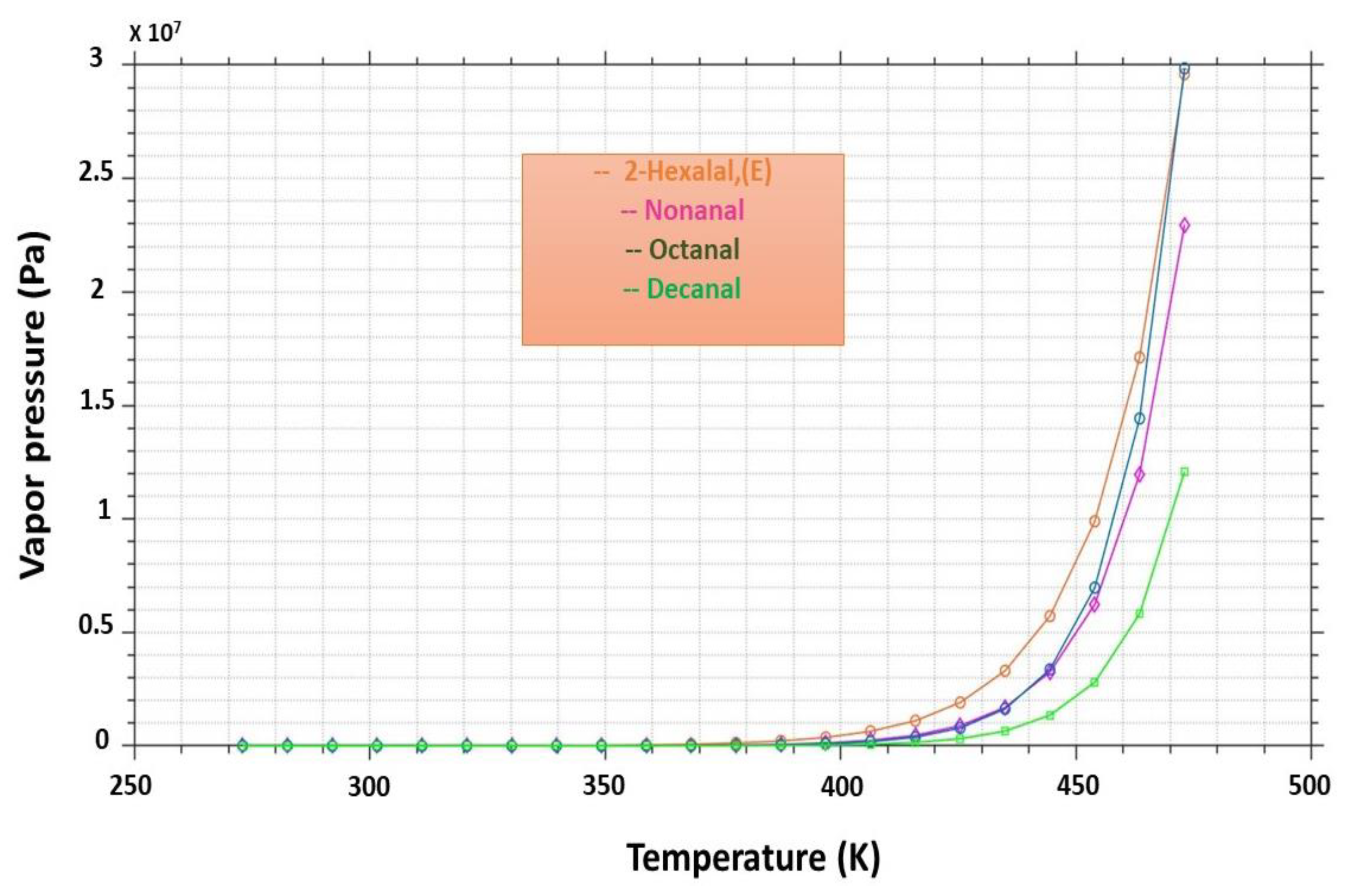
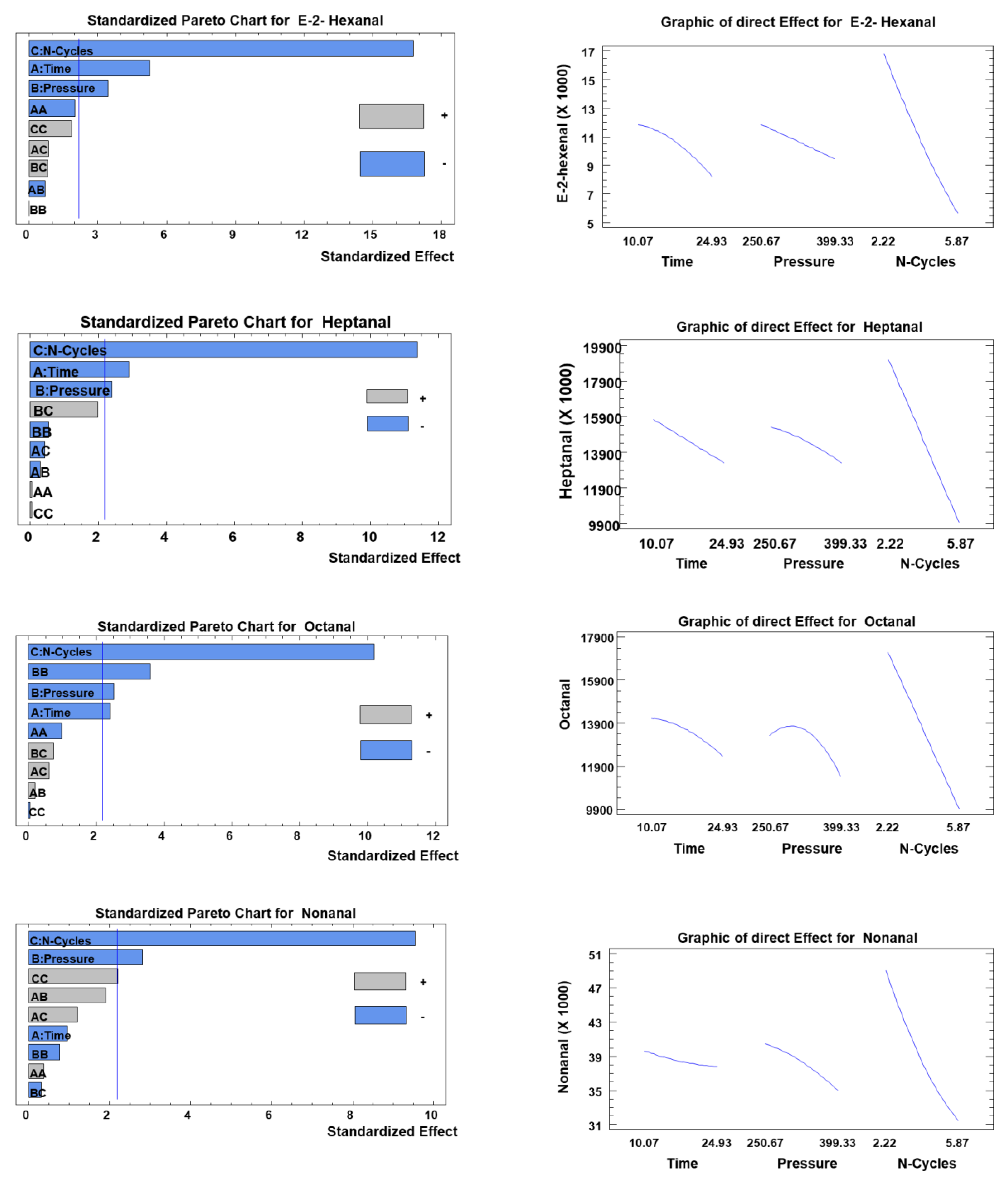

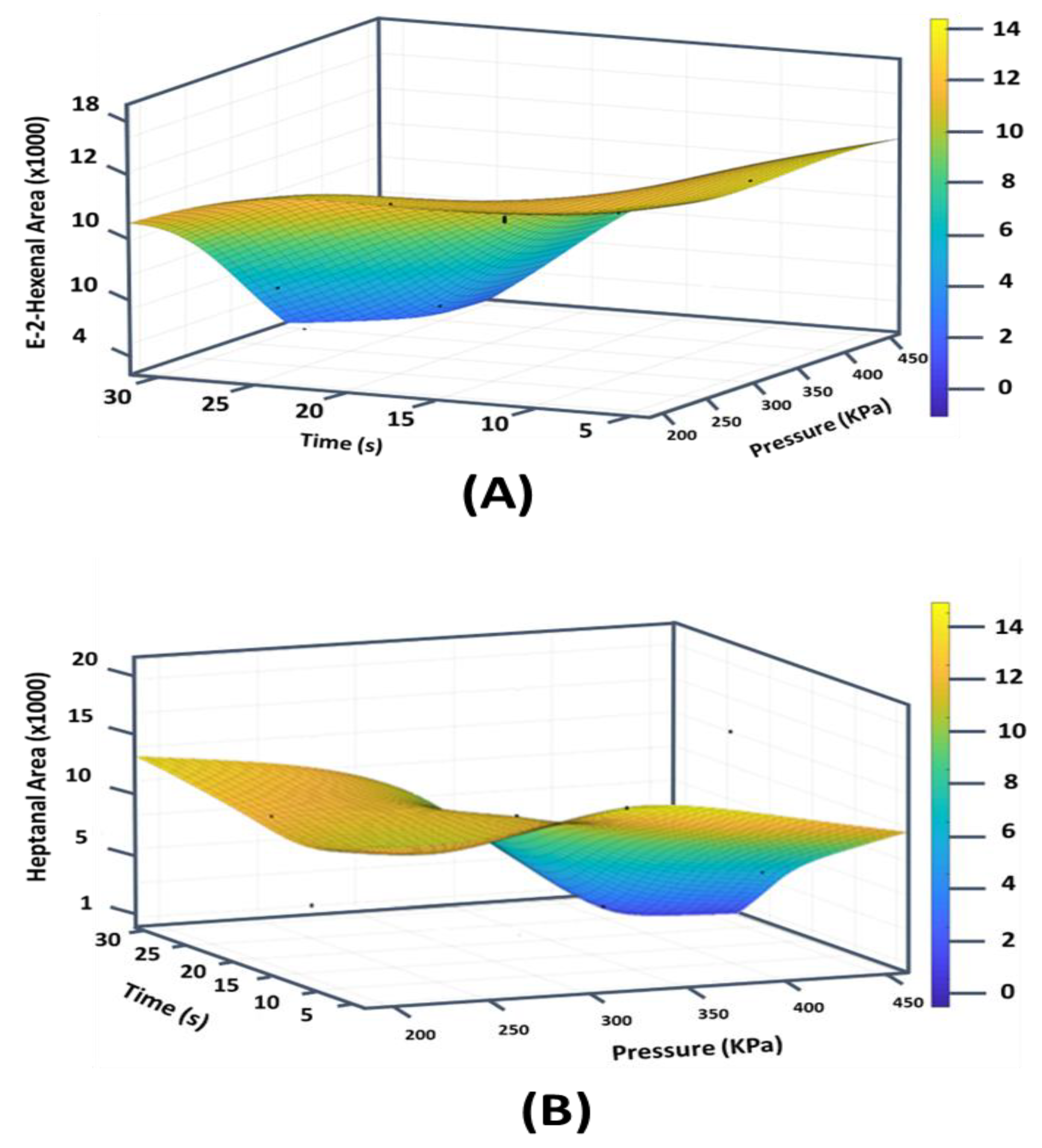
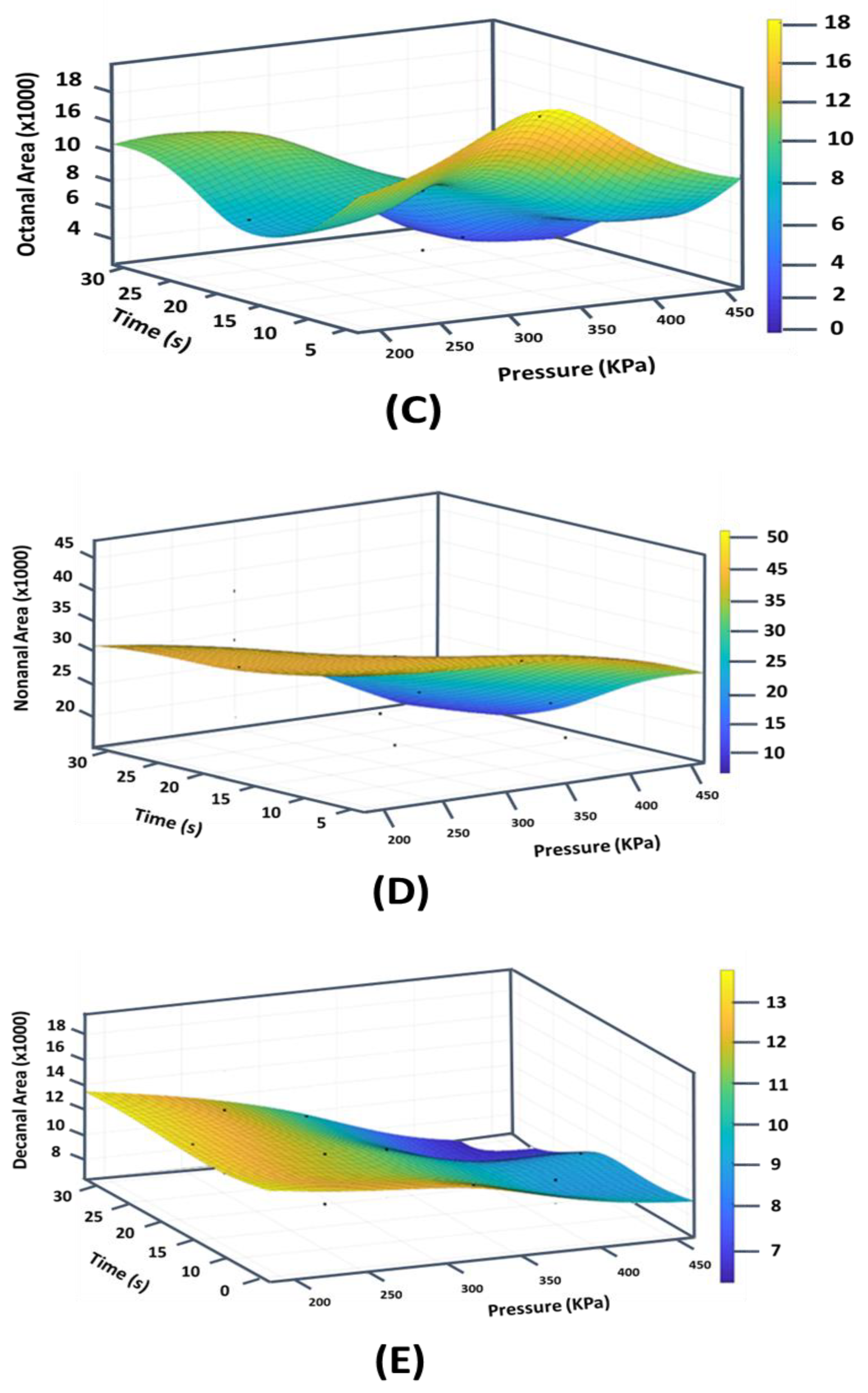
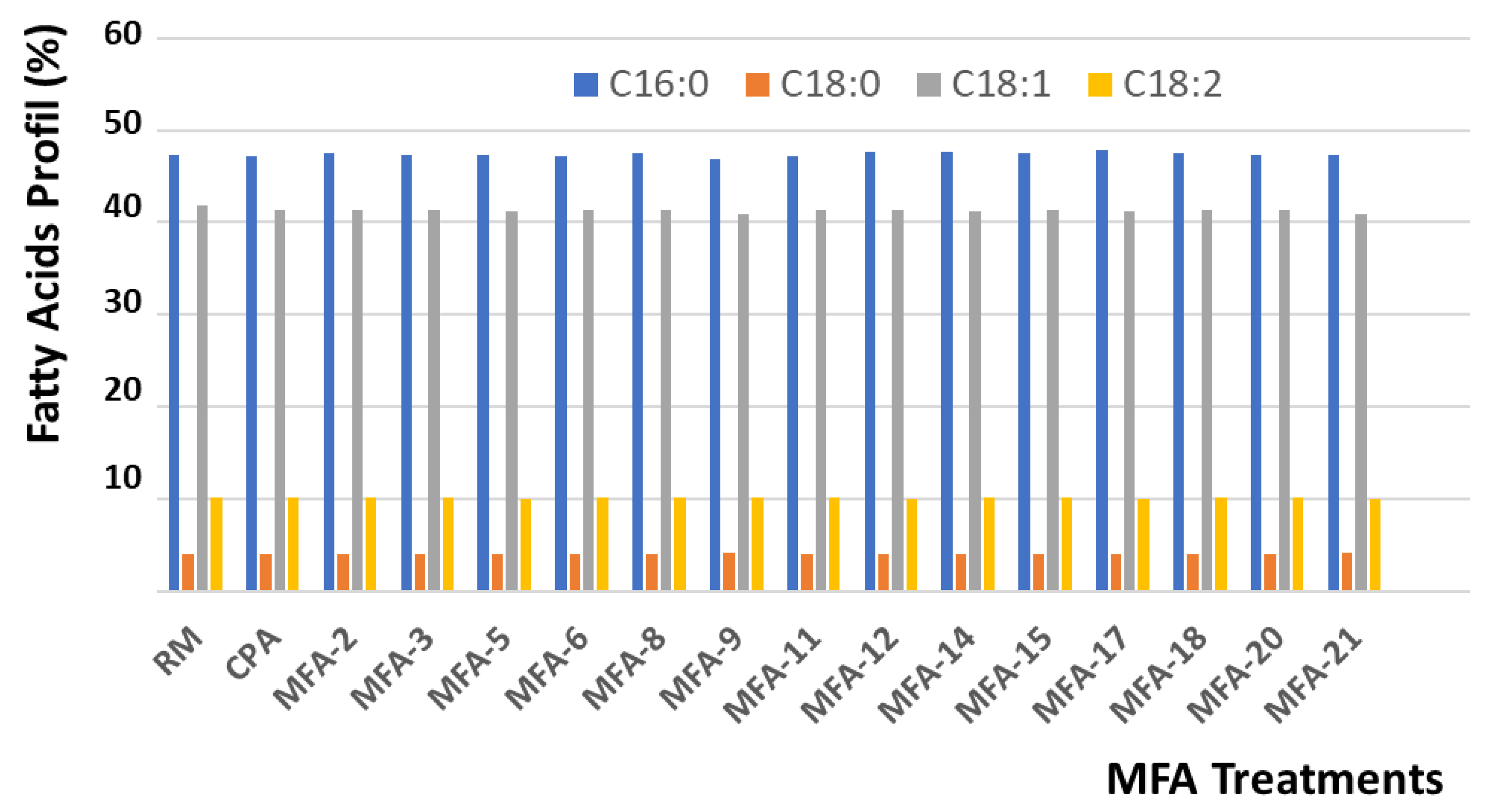
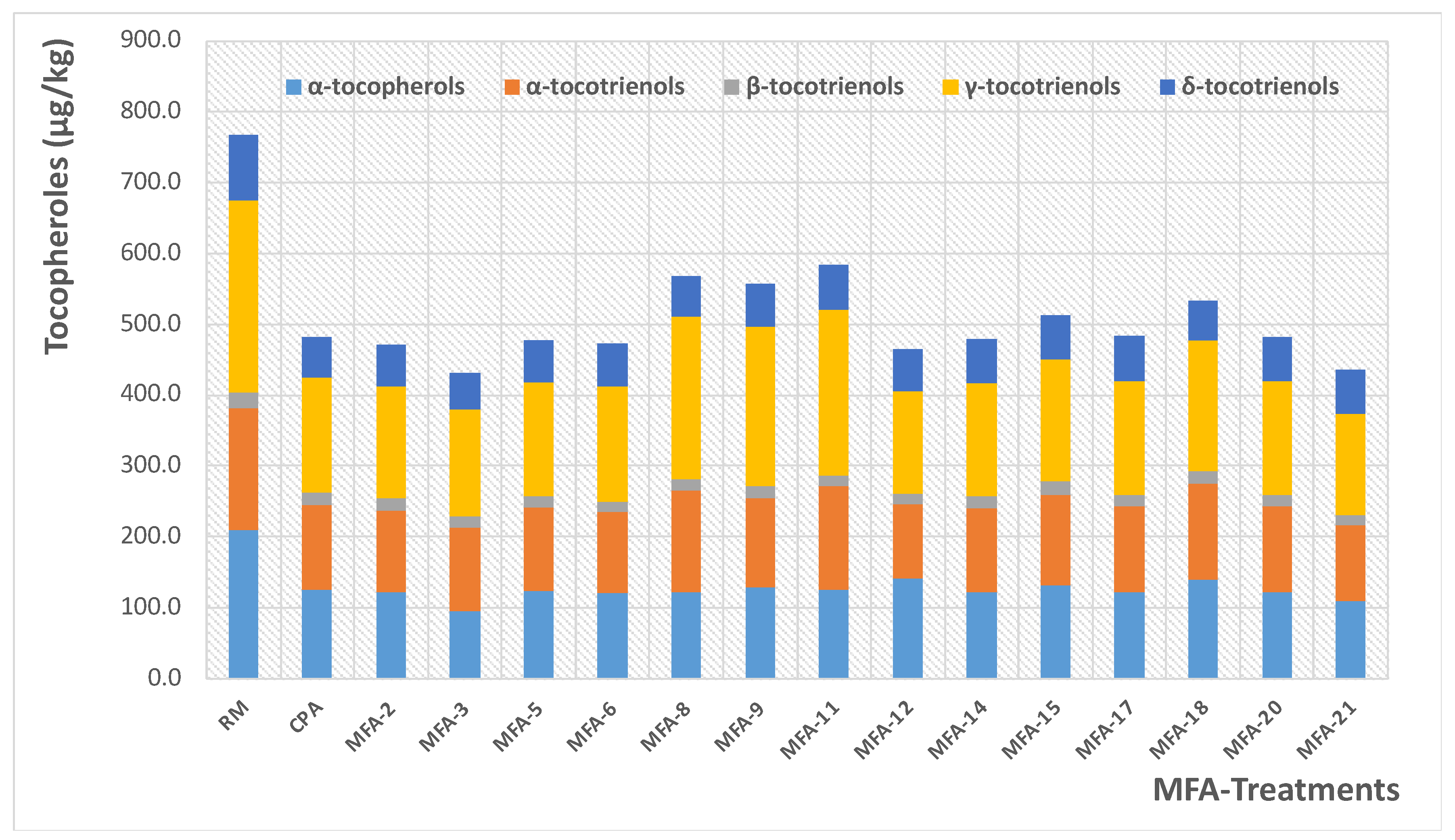
| Coded Values | −α | −1 | 0 | 1 | +α |
|---|---|---|---|---|---|
| Treatment time t (s/cycle) | 5 | 10.07 | 17.50 | 24.93 | 7.43 |
| Inlet oil pressure P (kPa) | 200 | 250.67 | 325 | 399.33 | 450 |
| Number of cycles C | 1 | 2 | 4 | 6 | 7 |
| Molecules | Volatile Compounds in Crude Palm Oil | ||||
|---|---|---|---|---|---|
| E−2-Hexenal | Heptanal | Octanal | Nonanal | Decanal | |
| Linear Retention Time (LRI) | 769 | 1104 | 1204 | 1350 | 1204 |
| Peak Area RM-1 | 22,985 | 26,255 | 19,876 | 61,589 | 20,326 |
| Peak Area RM-2 | 24,015 | 25,963 | 22,405 | 62,562 | 19,971 |
| Peak Area RM-3 | 22,966 | 28,029 | 21,253 | 63,601 | 20,072 |
| Profile (%) | 13.27 | 15.22 | 12.05 | 35.61 | 11.45 |
| Standard deviation | 462.0 | 853.3 | 868.0 | 678.0 | 135.3 |
| Average | 23,322 | 26,749 | 21,178 | 62,584 | 20,123 |
| Coefficient of variance | 0.020 | 0.032 | 0.041 | 0.011 | 0.007 |
| DoE Trials | t Time (s/cycle) | P Pressure (kPa) | C Cycles | Reduction Ratio RR (%) | ||||
|---|---|---|---|---|---|---|---|---|
| E−2-Hexenal | Heptanal | Octanal | Nonanal | Decanal | ||||
| RM | 0 | 0 | 0 | 1 | 1 | 1 | 1 | 1 |
| CPA | 18 | 325.0 | 4 | 56.7 | 51.3 | 48.7 | 57.6 | 55.1 |
| MFA-2 | 30 | 325.0 | 4 | 77.8 | 55.6 | 56.9 | 57.2 | 58.0 |
| MFA-3 | 18 | 325.0 | 7 | 84.0 | 77.8 | 70.7 | 67.7 | 61.0 |
| MFA-5 | 18 | 450.0 | 4 | 67.1 | 64.4 | 65.4 | 69.0 | 61.6 |
| MFA-6 | 18 | 200.0 | 4 | 42.4 | 48.0 | 56.0 | 48.7 | 43.6 |
| MFA-8 | 25 | 250.7 | 6 | 86.6 | 74.2 | 68.5 | 69.0 | 60.7 |
| MFA-9 | 10 | 250.7 | 2 | 22.8 | 34.3 | 27.9 | 40.7 | 39.6 |
| MFA-11 | 25 | 250.7 | 2 | 34.1 | 35.8 | 50.6 | 51.3 | 45.2 |
| MFA-12 | 10 | 399.3 | 6 | 81.4 | 75.3 | 69.4 | 72.5 | 60.2 |
| MFA-14 | 10 | 399.3 | 2 | 25.0 | 32.7 | 41.9 | 44.1 | 49.1 |
| MFA-15 | 10 | 250.7 | 6 | 75.4 | 69.9 | 65.4 | 61.2 | 59.2 |
| MFA-17 | 5 | 325.0 | 4 | 44.7 | 39.6 | 45.5 | 54.2 | 54.7 |
| MFA-18 | 25 | 399.3 | 6 | 87.3 | 78.7 | 75.1 | 62.4 | 65.1 |
| MFA-20 | 25 | 250.7 | 2 | 28.1 | 34.0 | 28.5 | 46.0 | 44.9 |
| MFA-21 | 18 | 325.0 | 1 | 12.0 | 23.1 | 25.5 | 34.4 | 40.1 |
| Standard deviation | 26.56 | 19.21 | 16.53 | 11.47 | 8.63 | |||
| Average | 51.65 | 49.73 | 49.80 | 52.30 | 49.95 | |||
| Coefficient of variance | 0.51 | 0.39 | 0.33 | 0.22 | 0.17 | |||
| MFA Treatments | E−2-Hexenal | Heptanal | Octanal | Nonanal | Decanal | |||||
|---|---|---|---|---|---|---|---|---|---|---|
| Model | F-Value | Proba | F-Value | Proba | F-Value | Proba | F-Value | Proba | F-Value | Proba |
| T | 73.43 | 0.0001 | 11.62 | 0.0052 | 5.46 | 0.0375 | 7.59 | 0.0174 | 0.11 | 0.7444 |
| P | 16.82 | 0.0015 | 12.63 | 0.0041 | 8.59 | 0.0126 | 6.17 | 0.0287 | 5.38 | 0.0388 |
| C | 498.22 | 0.0002 | 368.5 | 0.0001 | 60.86 | 0.0002 | 124.32 | 0.0001 | 75.36 | 0.0003 |
| T2 | 7.16 | 0.0202 | 0.76 | 0.4008 | 4.06 | 0.067 | 0.04 | 0.8545 | 0.1 | 0.762 |
| TP | 3.36 | 0.0918 | 1.78 | 0.2075 | 1.1 | 0.3156 | 0.12 | 0.7331 | 2.17 | 0.1666 |
| TC | 3.13 | 0.102 | 1.3 | 0.2766 | 0.12 | 0.7304 | 0.66 | 0.4315 | 3.76 | 0.0765 |
| P2 | 0 | 0.9932 | 10.51 | 0.0071 | 7.83 | 0.0161 | 3.56 | 0.0834 | 0 | 0.9506 |
| PT | 1.21 | 0.2934 | 0.1 | 0.7519 | 1.75 | 0.2111 | 1.49 | 0.2457 | 0.28 | 0.6071 |
| C2 | 11.33 | 0.0056 | 0.31 | 0.5868 | 0.13 | 0.7219 | 0.98 | 0.3411 | 5.54 | 0.0365 |
| R2 | 98.42 | 97.65 | 90.69 | 93.38 | 90.45 | |||||
| R2-Adj | 97.24 | 95.88 | 83.71 | 88.41 | 83.29 | |||||
| Model | Molecule Area | ||||
|---|---|---|---|---|---|
| E−2-Hexenal | Heptanal | Octanal | Nonanal | Decanal | |
| Constant | 30,673 | 12,137 | 8578 | 37,563 | 28,559 |
| P | −3.9 | 89.5 | 106.2 | 153.8 | −41.4 |
| T | 282 | −71 | −201 | −839 | −120 |
| NC | −5980 | −2433 | −2924 | −4408 | −2733 |
| P × T | −1.09 | −0.83 | −1.12 | 0.69 | 1.24 |
| P × NC | 2.46 | −0.76 | 5.33 | −9.12 | 1.68 |
| T × NC | 38.6 | 26.0 | −13.8 | 59.2 | −60.1 |
| P2 | −0.0003 | −0.1293 | −0.1923 | −0.2403 | 0.0034 |
| T2 | −10.23 | 3.48 | 13.85 | 2.39 | −1.68 |
| NC2 | 212 | −37 | −41 | 208 | 211 |
| R2 | 98 | 98 | 91 | 93 | 90 |
| Facteur Area | Control Value | Optimum Value | Optimum Reduction Ratio RR (%) | Pressure (kPa)/Temperature ( °C) | Time (s) | Numbers of Cycles |
|---|---|---|---|---|---|---|
| E-2-Hexenal | 23,322 | 2083.38 | 91.1% | 450 kPa/148 °C | 30.0 | 6.9 |
| Heptanal | 26,749 | 408.953 | 98.5% | 450 kPa/148 °C | 29.0 | 7.0 |
| Octanal | 21,178 | 154.464 | 99.3% | 450 kPa/148 °C | 28.9 | 7.0 |
| Nonanal | 62,584 | 7374.9 | 88.2% | 450 kPa/148 °C | 22.7 | 7.0 |
| Decanal | 20,123 | 3717.75 | 81.5% | 200 kPa/120 °C | 30.0 | 7.0 |
Publisher’s Note: MDPI stays neutral with regard to jurisdictional claims in published maps and institutional affiliations. |
© 2022 by the authors. Licensee MDPI, Basel, Switzerland. This article is an open access article distributed under the terms and conditions of the Creative Commons Attribution (CC BY) license (https://creativecommons.org/licenses/by/4.0/).
Share and Cite
Jamoussi, B.; Jablaoui, C.; Hajri, A.K.; Chakroun, R.; Al-Mur, B.; Allaf, K. Thermomechanical Autovaporization (MFA) as a Deodorization Process of Palm Oil. Foods 2022, 11, 3952. https://doi.org/10.3390/foods11243952
Jamoussi B, Jablaoui C, Hajri AK, Chakroun R, Al-Mur B, Allaf K. Thermomechanical Autovaporization (MFA) as a Deodorization Process of Palm Oil. Foods. 2022; 11(24):3952. https://doi.org/10.3390/foods11243952
Chicago/Turabian StyleJamoussi, Bassem, Cherif Jablaoui, Amira K. Hajri, Radhouane Chakroun, Bandar Al-Mur, and Karim Allaf. 2022. "Thermomechanical Autovaporization (MFA) as a Deodorization Process of Palm Oil" Foods 11, no. 24: 3952. https://doi.org/10.3390/foods11243952









